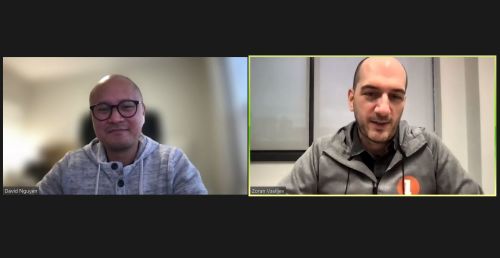author

Senior Vice President, Global Growth
published-on
26 Feb 2021
tags
With the pandemic, the way we live and work changed. Things that seemed like an irrelevant, digital alternative available because science has advanced became a bare necessity - for example, appearing well on the screen at an online meeting.
Just like to billions around the world, the pandemic has shown us our resilience and adaptability. It has also shown us where we at Centili should improve if we want to keep winning. Being able to influence and persuade people online was one of the things we wanted to improve. Sure, we can count on our sales people’s charisma and charm when they sit down at a dinner table with potential clients. But what happens when the only possible venue is a Zoom meeting?
In our pursuit of answers, we invited Lee Warren, a keynote speaker and author of “The Busy Person’s Guide to Great Presenting”, as a special guest during Centili Anniversary Week in January. Among the brilliant, action-oriented observations and tips, we focused on the ability to read others’ needs and on the power of persuasion.
Check out the video snippet of the webinar below.
Lesson no. 1 - Use the technology to showcase soft skills
We all know what soft skills are. We are especially conscious of them when they are lacking: having a great expert that doesn’t deal with people well ultimately deteriorates the company culture and even produces lesser hands-on results. But, as Lee Warren explains, soft skills, and soft skills in a virtual environment, are not the same. He points out two basic mistakes people make when meeting online.
Mistake no. 1 - The assumption that people will pay attention like in the offline world.
“Online, people have the attention span of a 3-year-old and the memory of a 90-year-old”, says Warren. The fact is that the entire business world has moved online during the past year, and people quickly adapted to the new communication dynamics. We all see the work more fluidly, intersecting our tasks with casual meetings, multitasking and checking email while on the call with colleagues.
The downside to this increased efficiency is this: our online presence is not as captivating as in the real world, and we must put a special effort to capture people’s attention. In the virtual environment, repeating what we’d say in the real world isn’t enough.
Mistake no. 2 - Not embracing all of the possibilities of virtual technology.
“All of you with a laptop or desktop computer, or even smartphone - have a multimedia broadcast studio sitting in your pocket!” Indeed, just ten years ago, the technical possibilities of today’s virtual technology were unimaginable. Our super advanced smartphones, fast internet connection, and built-in phone cameras make online meetings not just possible but preferable.
For just the cost of Wi-Fi, you can reach millions around the world. Yet, many treat this technology like a nuisance, something we need to live with until the virtual work is gone. The truth is, virtual work is going nowhere, and we may as well use the best of its possibilities.
Aside from the broader reach and instant connection with the audience, the virtual business creates a more intimate, immediate experience. The receptionists we are used to in a corporate environment are simply not here as gatekeepers, which gives us a window of opportunity and a more direct experience with meetings.
Finally, it’s become possible to have blitz, punchy meetings, a kind that would be considered somewhat odd due to social courtesies in the real world.
As the dynamics of the meetings have changed and the technology we use has given us the sharpness and effect, what are the things that remained universal to the online and offline world? Let’s dive into it.
 Lee Warren at the Centili Anniversary Week webinar
Lee Warren at the Centili Anniversary Week webinar
Lesson no. 2 - If you use meetings to give information, you may want to rethink it
“If you think about it carefully, speaking face to face is not the best way to send information. People will forget stuff and make judgements based on your looks. It’s much more effective to write an email.”
Speaking face to face is great for something else: for affecting people with the information. It’s brilliant for building trust, credibility, relationships, and persuading and winning over. Warren advises us to go for the emotional connection first and then go for the intellectually engaging stuff.
Before his prosperous career as a presenting consultant, Lee Warren used to be a magician. One of the best in the UK. It is no wonder that he is so resourceful in using different tactics to trick your mind into remembering stuff. He came up with an acronym to help people not forget the basics of any impactful face-to-face conversation.
The HAM PIE Acronym
The HAM stands for Hearts And Minds. Warren reminds us that we must engage people’s empathy and interest before presenting them with the information. Before speaking to a room full of people, we must open the door, and the heart is the door. You want to get an emotional connection.
The other part of the acronym (PIE) stands for great ways to get an emotional connection.
P stands for pictures. Try to use a language and format that provide the obvious facts that are innately easy to understand - use the visual manner. Some excellent materials to provide for virtual meetings include pictures on slides, case studies, testimonials - concrete examples, stories, metaphors, analogies, and easy comparisons.
I stands for interest. ”One of the least interesting things to hear in this world is, ‘Hello, let me tell you about myself.’ In contrast, one of the most exciting things to hear is, ‘Hello, tell me about yourself.’ Tailor the message to be interesting to the other party,” says Warren.
One of the most common mistakes in sales is talking about your own service, technology, or product, instead of assessing which parts of what you have are interesting to others and crafting the message to resonate with them. Opening the conversation with the “me” talk isn’t going to get you very far. Instead, find engaging, relevant, and valuable points to people you are talking to.
E is for enthusiasm. Before going and meeting clients, it is essential to persuade yourself first. People can see it in your eyes and hear it in your voice whether you believe in the idea you are selling or not. Your self-persuadedness level is particularly noticeable in the virtual environment, where your appearance is already a bit less self-assured because of the self-consciousness brought by speaking to a camera and seeing yourself in the corner of the screen.
Meeting face-to-face is an opportunity to build the emotional connection that will shape the perception of the information you will provide afterwards. Furthermore, using the meeting to “present the information” will prove a futile effort, as the informative content itself gets a much better reception in solitary consumption.
Lesson no. 3 - Build trust by understanding, first.
The complex human psychology shows many layers to a successful exchange of value. Trust is one of those layers we need to capture someone’s attention further and win them over. Having someone’s trust means understanding them, showing that you know who they are, and doing something for their benefit as much as your own.
Earn a PhD in your customers’ world
When we want to understand, we must invest time and effort in researching and pondering our customers’ point of view. Being aware of their problems provides essential ammunition for all future communication.
“We all love to buy. Most of us also hate to be sold to. As much as we don’t want to engage with people who push their service on us, we love to engage with people who understand us,” says Warren.
Lee Warren suggests to write down a hundred problems that your clients or team members have at the moment. You will find the first ten or so relatively straightforward. It starts to be a bit difficult after that. You begin to understand why your clients behave the way they do, and once you pass 50 problems, you truly understand what they face. The more you know your customers, the more great selling points you’ll have.
“Remember, people don’t buy a drill; they buy the hole in the wall.” When we approach our customers, we need to learn more about the kind of hole they want, their wall quality, and their ultimate intentions, such as hanging the picture on it.
Lesson no. 4 - The Six E’s and the power of a great meeting experience
1 - Environment - How you look in your space. Make a scenery behind you so that the scene behind you is consistent with what you’re talking about. Take care of the lighting: make sure you have some light behind the camera falling on your face. The audio quality is also important. Experiment with the position of your equipment, and even invest in an external microphone. Place your camera at eye level or a bit above. Make sure you’re looking into the lens or slightly upwards from the lens.
2 - Experience - Always ask yourself what the experience is for the other party. If you’ve ever been to a boring meeting, try and not repeat it for others. Never read your slides. Keep things moving. The changing graphics, moving images, ad polls help invigorate the meeting.
3 - Eyes - However awkward it may feel to stare at the tiny lens on the top of your screen, it’s best if you keep looking at it. It gives the viewers a sense of connection and your total investment in the talk. Put a sticky note with an arrow or a smiley face next to the lens to remind you you should look there.
4 - Engagement - Ask questions, post polls, send reading materials in advance, such as physical copies via mail and ask them to engage with them during the call. Use anything you can think of that makes people not be just passive observers but engage.
5 - Energy - Bring yourself to sit in front of your chair, put both of your feet flat on the floor and sit upwards. If you bring one foot a bit forward, you’ll naturally lean toward the camera and bring engaging energy.
6 - Empathy - be empathetic toward your counterparts at the meeting. Come prepared, keep it as short as possible, and respect their time.
Lesson no. 5 - Don’t focus on the long-term goal at every meeting
One of the important lessons for any sales team is to have a clearly defined, short-term goal for every meeting. In the B2B environment, there can be an average of eight sessions before the buy-in, and each step of the way should have its goal. The first meeting’s purpose can be, for example, getting a second meeting with another person. Or, it can be acquiring the necessary knowledge to pursue further discussions. Having a clear short-term goal helps shape the message and narrows down your meeting’s focus.
Before every meeting, ask yourself what you can do to deliver a world-class experience to your client. Each session should show your competency, effectiveness, and empathy towards the clients’ needs.
At Centili, we have made it a strategic point to base our value on customer intimacy and a world-class customer journey. Turning to virtual business has impacted the way we communicate with our clients, and we are open to learning how to be more efficient and close to our customers’ needs.
Leveraging our expertise and skills to bring the utmost value to our customers is our top priority. We are happy for the opportunity to learn how we can improve!
If you want to receive Centili news and blog posts to your inbox, feel free to subscribe to our monthly newsletter below.





